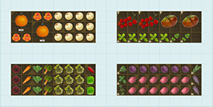Basics
- Ease of Growing
- Easy
- Grown as
- Annual
- Days to Maturity
- 90-130 (Spring/Summer), 225-240 (Fall/Winter)
- Growing Habit
- -
- Hardiness
- Hardy
Garlic is very hardy and if the soil doesn't freeze the roots will continue to grow right through the winter. The tops will grow whenever the temperature is above 40 degrees F. Garlic can sometimes be frost tolerant.
- Crops
- Spring, Fall
- Growing Season
- Short, Long
- Cultivar Type
- -
- Growing Conditions
- Cold, Cool, Warm, Long days
Garlic is a fairly easy crop to grow. Given lots of sun, good soil, plenty of water, and a steady supply of nutrients, and it will produce maximum leaf growth, which in turn produces large bulbs. Garlic is quite hearty and can grow during the winter in more moderate climates. In colder areas, it can be planted in the spring.
- Outdoor Growing Temp
- 45°F - 85°F
- Min Outdoor Soil Temp
- 45°F
Garlic is a very hardy plant and can go into the ground 4 to 6 weeks before the last frost date.
- Start Indoors
- No
- Start Outdoors
- Yes
- Light
- Water
- Low
This is another critical factor in growing good garlic. The plants need a steady and constant supply of moisture when putting on leaf growth and bulbing up.
- Feeder
- Moderate
Moderate nitrogen. Moderate phosphorous. Moderate potassium. Garlic isn't a very hungry plant, but it needs a steady supply of nutrients for best growth.
- Suitability
- Tolerates light frost
- Small Gardens?
- Yes
- Containers?
- Yes
You could try growing garlic in a container (make sure the pot is at least 12" deep and 6" in diameter), but it isn't considered an ideal candidate for this. Plant one clove per pot no more than 1 1/2 inches below the surface of your potting soil. Water well and place in the sunshine.
- Attracts beneficial insects?
- No
- Color
- Papery white
- Fruit Size
- 1.5 - 3.0"
- Plant Height
- 12.0 - 24.0"
- Plant Diameter
- 2.0 - 3.0"
- Good Companions
- Raspberry
- Bad Companions
- Bean, Peas
- Hardiness Zone
- 5-10
- Disease Resistance
- -
- Taste Profile
Hot and spicy flavor
- Rotation Group
- Roots: Alliums + Umbeliferae

